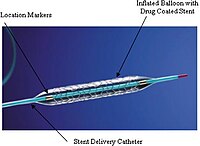
Photo from wikipedia
Background: Clinical and morphological factors associated with lipidic versus calcified neoatherosclerosis within second-generation drug-eluting stents and the impact of lipidic versus calcified neoatherosclerosis on long-term outcomes after repeat intervention have… Click to show full abstract
Background: Clinical and morphological factors associated with lipidic versus calcified neoatherosclerosis within second-generation drug-eluting stents and the impact of lipidic versus calcified neoatherosclerosis on long-term outcomes after repeat intervention have not been well studied. Methods: A total of 512 patients undergoing optical coherence tomography before percutaneous coronary intervention for second-generation drug-eluting stents in-stent restenosis were included. Neoatherosclerosis was defined as lipidic or calcified neointimal hyperplasia in ≥3 consecutive frames or ruptured lipidic neointimal hyperplasia. The primary outcome was target lesion failure (cardiac death, target vessel myocardial infarction, definite stent thrombosis, or clinically driven target lesion revascularization). Results: The overall prevalence of neoatherosclerosis was 28.5% (146/512): 56.8% lipidic, 30.8% calcified, and 12.3% both lipidic and calcific. The prevalence increased as a function of time from stent implantation: 20% at 1 to 3 years, 30% at 3 to 7 years, and 75% >7 years. Renal insufficiency, poor lipid profile, and time from stent implantation were associated with lipidic neoatherosclerosis, whereas severe renal insufficiency, female sex, and time from stent implantation were associated with calcified neoatherosclerosis. Multivariable Cox regression revealed that female sex and lipidic neoatherosclerosis were associated with more target lesion failure, whereas stent age and final minimum lumen diameter after reintervention were related to lower target lesion failure. Calcified neoatherosclerosis was not related to adverse events after reintervention for in-stent restenosis given a large enough minimum lumen diameter was achieved. Conclusions: Lipidic but not calcified neoatherosclerosis was associated with poor subsequent outcomes after repeat revascularization if optimal stent expansion was achieved in lesions with calcified neoatherosclerosis.
Journal Title: Circulation: Cardiovascular Interventions
Year Published: 2022
Link to full text (if available)
Share on Social Media: Sign Up to like & get
recommendations!